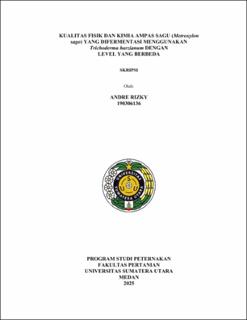Kualitas Fisik dan Kimia Ampas Sagu (Metroxylon sago) Yang Difermentasi Menggunakan Trichoderma harzianum Dengan Level Yang Berbeda.
Physical and Chemical Quality of Sago Residue (Metroxylon sago) Fermented with Trichoderma harzianum at Different Levels

Date
2025Author
Rizky, Andre
Advisor(s)
Tafsin, Ma’ruf
Daulay, Armyn Hakim
Metadata
Show full item recordAbstract
Sago residue is a byproduct or leftover from the process of extracting sago starch from the trunk of the sago palm (Metroxylon sago). The utilization of sago residue as livestock feed is hindered by its high crude fiber and low crude protein content, making fermentation with Trichoderma harzianum necessary. This study aimed to determine the effect of fermentation with various levels of Trichoderma harzianum on the physical and chemical quality of sago residue. The experimental design used in this research was a Completely Randomized Design (CRD) with five treatments and four replications. Treatments included P0 = 250 grams of sago residue without Trichoderma harzianum; P1 = 250 grams + 0.2% Trichoderma harzianum; P2 = 250 grams + 0.4% Trichoderma harzianum; P3 = 250 grams + 0.6% Trichoderma harzianum; and P4 = 250 grams + 0.8% Trichoderma harzianum. The results indicated that fermenting sago residue with Trichoderma harzianum over varying incubation periods resulted in a sour aroma, brown color, and soft texture for the physical quality. Statistical analysis of average values for aroma, color, and texture showed significant differences (P<0.05). Chemical analysis showed that fermentation with Trichoderma harzianum had no significant effect (P>0.05) on crude fiber and crude fat but had a significant effect (P<0.05) on crude protein content. The best results were obtained in treatment P4 with a Trichoderma harzianum level of 0.8%.
Collections
- Undergraduate Theses [840]
